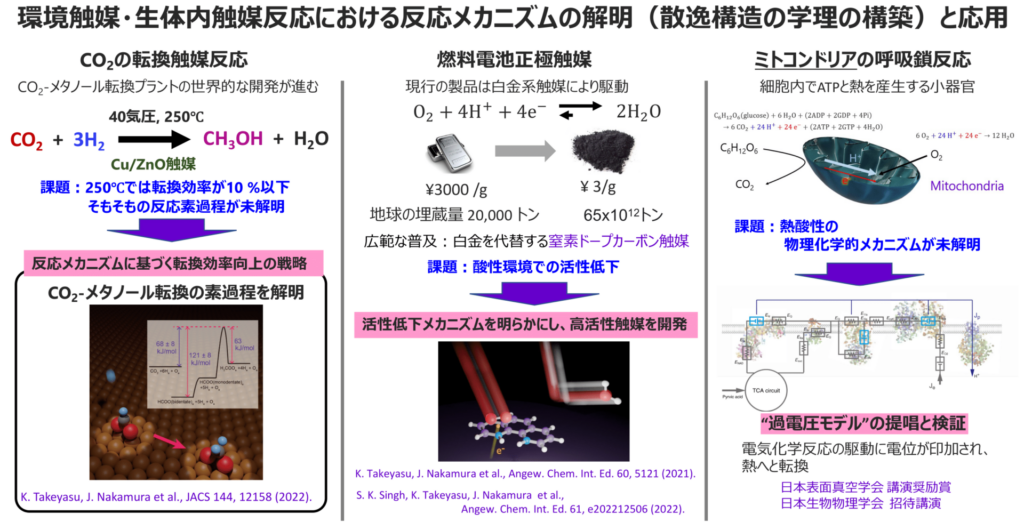Strategic Professional Development Program for Young Researchers
Top Runner Development Program Engaging Universities,
National Labs, and Companies
Fellows (2nd-term)

TAKEYASU, Kotaro
Assistant Professor
Institute of Pure and Applied Sciences
University of Tsukuba
- Research fields
- Surface science, Surface chemistry of catalysis
- Research project
- Investigating mechanism and development of catalysis
- Keywords
- Catalysis, Reaction mechanism
- Researchers Information
- https://trios.tsukuba.ac.jp/researcher/0000004091
- researchmap
- https://researchmap.jp/ktakeyasu
Biography
Education
2014 PhD in applied physics, Univ. Tokyo
2011 ME in applied physics, Univ. Tokyo
2009 BE in applied physics, Univ. Tokyo
Positions
2018-present Assistant professor, Institute of Materials Science, Univ. Tsukuba
2017-2018 Postdoctral researcher, Department of Chemistry, Kyoto Univ.
2015-2017 Postdoctral researcher, Department of Chemistry, Osaka Univ.
2014-2015 Postdoctral researcher, Institute of Inductrial Science, Univ. Tokyo
Research Outline

I am working on catalytic reactions. A catalyst is a substance that accelerates a chemical reaction without final change of the structure. Chemical reactions proceed on the surface of a catalyst, but there are not many systems whose mechanisms have been clarified at the molecular level. I am conducting research to clarify the mechanisms of reactions and link this knowledge to the development of catalysts. As specific systems, we have focused on the conversion reaction of CO2 into useful chemical products (alcohols) and the cathode reaction of hydrogen fuel cells, which are important in carbon neutrality. In the case of methanol synthesis from CO2 , we clarified the elementary process that determines the reaction rate, which has been debated for half a century. Current commercial hydrogen fuel cells use platinum as the cathode catalyst. Since platinum reserves are limited, we have investigated metal-free nitrogen-doped carbon catalysts as alternatives to platinum. We have clarified the deactivation mechanism in the acidic environment of fuel cell cells, and have succeeded in developing a catalyst with the highest level of activity based on the mchanism. In addition, more complex catalytic reactions are in progress in the biological systems. We are trying to clarify the energetic mechanism of the respiratory reactions in mitochondria in cells combined with heat generation. In addition, the transmission of new coronaviruses has an analogy with the progression of catalytic reactions. We are also developing quantitative evaluation methods for the effectiveness of measures such as contact tracing and the number of resources required, taking advantage of the characteristics of catalytic reaction analysis.
What is my goal as a transborder researcher?
私の研究の軸は、触媒上での化学反応の流れを理解し、一般化して、それを応用することであると考えていますので、不均一系触媒上での気体・液体の反応ではなくても、感染症の伝播のような”触媒反応” があって、相互理解のある他分野の研究者とチームを組めるのであれば、垣根を自分で作ることなく、取り組んでいきたいと考えています。相互の分野に新しい視点、アプローチが取り込まれるだけではなく、境界から新しい学問体系が生まれてくることを期待します。一般的なボーダーがあると理解していることは重要ですが、その上でボーダーを感じずに行動できる研究者を目指したいです。
The pillar of my research is to understand, generalize, and apply the flow of chemical reactions on catalysts. Therefore, even if it is not a gas or liquid reaction on a heterogeneous catalyst, I would focus on "catalytic reaction" such as the spread of an infectious disease organizing a team with researchers in other fields with mutual understanding. I would like to work on it without creating barriers by myself. I expect not only that new perspectives and approaches will be incorporated into both fields, but also that new body of knowledge will emerge from the boundaries. It is important to understand that there is borders, but I would like to become a researcher who can act without feeling the borders.
Movies
Related article
In Preparation.
